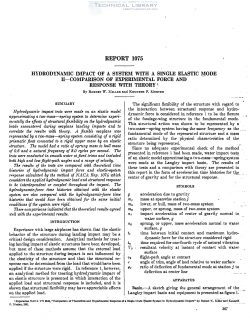naca-report-1075

- Version
- 167 Downloads
- 897.60 KB File Size
- 1 File Count
- September 7, 2016 Create Date
- September 7, 2016 Last Updated
National Advisory Committee for Aeronautics, Report - Hydrodynamic of a System with a Single Elastic Mode, II - Comparison of Experimental Force and Response with Theory

Hydrodynamic impact tests were made on an elastic model
approximating a t-wo-mass—spring system to determine experi—
mentally the efieets of structural flexibility on the hydrodynamic
loads encountered during seaplane landing impacts and to
correlate the results with theory. A flexible seaplane was
represented by a t-wo-mass—spring system consisting of a rigid
prismatic float connected to a rigid upper mass by an elastic
structure. The model had a ratio of sprung mass to hull mass
of 0.6 and a natural frequency of 3.0 cycles per second. The
tests were conducted in smooth water at fixed. trims and included
both high and low flight-path angles and a range of relocity.
The results of the tests are compared with theoretical time
histories of hydrodynamic impact force and elastic-system
response calculated by the method of NACA Rep. 1074 which
considers the applied hydrodynamic load and structural response
to be interdependent or coupled throughout the impact. The
hydrodynamic-fine time histories obtained with the elastic
system are also compared with the hydrodynamic-force time
histories that would have been obtained for the same initial
conditions if the system were rigid.
Experience with large airplanes has shown that the elastic
behavior of the structure during landing impact. may be a
critical design consideration. Analytical methods for treat-
ing landing impact of elastic structures have been developed,
but most of these methods assume that the external load
applied to the structure during impact is not influenced by
the elasticity of the structure and that the structural re-
sponse can be determined from the load that would have been
applied if the str'ucture were rigid. In reference 1, however,
an analytical method for treating hydrodynamic impact of
an elastic structure is presented in which interaction of the
applied load and structural response is included, and it is
shown that structural flexibility may have appreciable effects
on the applied load.
| File | Action |
|---|---|
| naca-report-1075 Hydrodynamic of a System with a Single Elastic Mode, II - Comparison of Experimental Force and Response with Theory.pdf | Download |

Comment On This Post